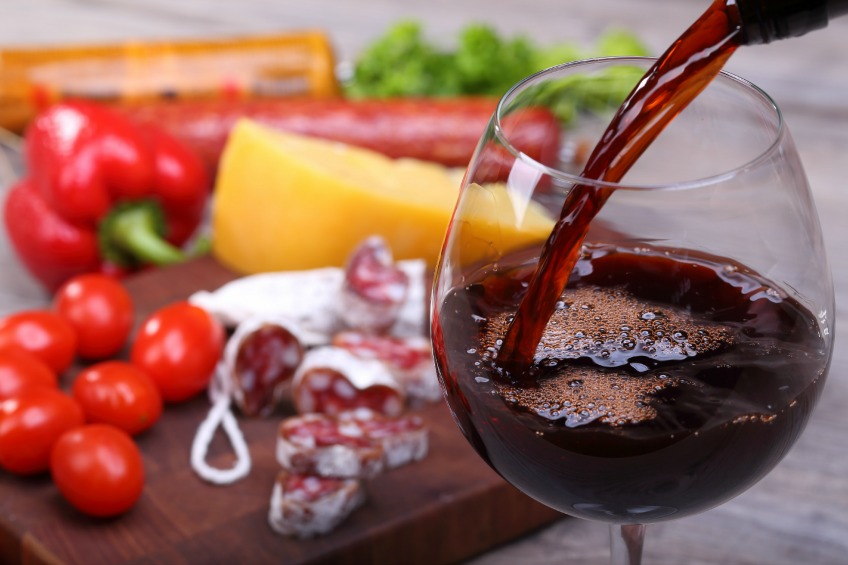Wine tasting does not have to be as complicated as people make it out to be as long as you understand the basic principles and learn what to look out for; every palate is different and therefore people’s perceptions of wine will vary.
Our beginner’s wine tasting guide will teach you the most important steps on how to taste wine.
The first step is to break down the tasting process into two categories. The first part consists of the taster’s personal objective view – this includes how the wine appears to that person, what the colour is, how it smells on your nose and tastes on your palate. The second part uses the information gained from these personal views to help draw a conclusion. These can range from the price of the wine, its grape variety, food pairings and origin. The key is to understand what to actually look for and knowing this will help you differentiate the varying factors.

Understanding Your Nose
50% of taste comes from the smell, and a large amount of satisfaction can be gained from smelling a wine before you drink it. By swirling the wine before you taste, you release some of the aromas of the wine. These can be delicate and elegant, but also pungent and strong. It will help you get a basic understanding of the wine.
Your nose can help you learn the condition of the wine and what faults it may hold. A few examples of what to look out for are:
Reduction: The smell of rotten eggs or boiled cabbage can be associated with this wine production technique. Low levels of reduction are described as minerality or stony and offer more complex fruit flavour and character. High levels are quite unpleasant, leading to that stinky character.
Oxidation: The opposite of reduction, the wine will be a browner colour and offers aromas of toffee, caramel and honey. The fault would be high levels of dissolved oxygen and this reduces the amount of fruit flavour.
TCA (Trichloroanisole): A taint that is reminiscent of damp cardboard and can reduce levels of fruit flavour and freshness. Low levels are difficult to detect but high levels usually means the wine has either been tainted by the cork or due a problem in the winery.
In terms of detecting aromas, we break it down into three different sub-categories:
Primary: These are your dominant fruity and floral aromas and the ones that mainly help you to distinguish one grape from another.
Secondary: These aromas are your background flavours and do not come from the grape but rather the production process. Oak is a prominent secondary flavour and depending on the type of oak used aromas include coconut, vanilla, tobacco, leather and cedar. If the wine has gone through malolactic fermentation we gain nutty and buttery flavours, and if the wine has been developed through lees contact (dead yeast cells) then flavours of yeast, cream and biscuit are pronounced.
Tertiary: These aromas come from the ageing process of the wine. If the wine has been oxidised for a long time in oak barrels then aromas of coffee, toffee and chocolate will be prominent, along with the secondary aromas from the oak itself such as coconut. If the ageing process is a reductive one (protected from oxygen, usually in the bottle) then more earthy flavours such as mushroom and vegetables come to the fore.

Understanding Your Palate
Whilst actual flavour is detected on the palate, it is the wines sugar, tannin and acid components that are perhaps the most crucial aspects to consider when tasting a wine. It is these that affect food pairings and the style of the wine itself.
Sweetness: It is the sugar level that determines the sweetness of the wine, the residual sugar left after fermentation, however alcohol and fruit flavours can also increase the perception of sweetness, the same way acidity can mask it. It can also affect body and texture. A dry wine that has a slight detectable amount of sweetness is classed as ‘off-dry’. This is the case for many Alsace and German Rieslings. Medium-dry to medium-sweet are wines that have a distinct presence of sugar but are not classed as dessert wines. The difference between medium-dry and medium-sweet is that the former are the wines where the acid masks the sweetness, for example in many Vouvray demi-secs, and the latter includes wines where the sweetness is more pronounced such as German Riesling Kabinett. We then come to the dessert wines and find stars such as Sauternes and Tokaji which are generally much more luscious in body and texture.
Acidity: This is where the freshness of the wine comes from. Acids in the wine are generally malic and tartaric or lactic; however other odourless acids can be added at the winery to give that sharpness. It is what gives the tongue that tingling sensation and causes your mouth to water. The longer your mouth waters, the stronger the acid in the wine. Going back to the idea that acidity can mask sweetness, it is the same the other way around, so to test that acidity level even in sweet wines, look for your mouth to water. All wines are acidic; however white wines always have higher levels than red or rose.
Tannin: These are the lip-smacking flavours that occur from the compounds in the skins of red grapes and a few white grapes along with wines that have been oaked and from the stems and seeds of the grape. They cause dry-mouth and have a bitter flavour that occurs towards the back of the tongue. This contributes to the texture and complexity of the wine. Generally, tannins are most apparent in red wine. A bitter white wine flavour can come through if it has been heavily oaked. However a robust Cabernet Sauvignon or Shiraz are the ideal grapes to taste these flavours.
Body: This is the general feel of the wine in the mouth, the overall impression. A good general rule to follow is that the higher the alcohol content, the higher the tannin level and the more intense the flavour the fuller the wine will be, and vice-versa.
Finish: The finish is the sensation after you swallow or spit out the wine. This is a good indicator for quality as the longer the desirable impression lasts, the higher in quality the wine tends to be. For a wine to have a ‘short’ finish, the flavours will often dissipate within a few seconds. This is associated with the lower end of the scale for scale. For your higher end, the finish should be ‘long’ and leave a desirable aftertaste for a minute or so.
Drawing Your Conclusion
Balance: It is so important to consider the balance of the wine when analysing its quality. The balance between fruit and sugar must be in accordance with acidity and tannin levels. Too much fruit or sugar and the wine will seem too thin, too much acidity or tannin will leave the wine a little unstructured. Each component has to harmonise together otherwise it will be of poor quality. This rings true for your primary, secondary and tertiary flavours as well.
Length: The longer the desirable aftertaste, the better the wine.
Concentration: The more concentrated the flavour does not necessarily mean a high quality wine because you have to think of the balance. Of course, wines that are weak and seem diluted are not quality products but each component has to fit into the overall balance of the wine. However, generally, the concentration of flavours and structure are usually indicative of a quality wine.
To learn more about tasting wine, read Jack’s next article in the series – How to Taste Wine and Appreciate it. For more information on wine and food pairing, read our wine and food pairing guide here.